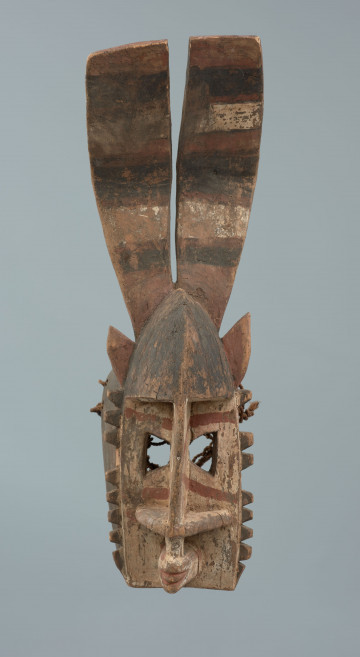
Gomintogo mask
między 1951 — 2000
National Museum in Szczecin
Part of the collection: Collection of Dogonian art
The satimbe mask worn on the face forms a whole with the complete costume. The word satimbe comes from the Dogo-so language and means a put-on sister (implicitly: on the head). In the Sigi-so ritual language, the mask is called awa danu, meaning a mask made of wood.The interpretation of satimbe is very complicated because its form is read and interpreted anew at each successive stage of initiation, which circumcised men access over many years. The first level of initiation places it in the world of the Andumbulu - the lowly, mythical inhabitants of the bush. The figure on the finial is an image of an Andumbulu woman who discovered red fibres and used them to disguise herself. The men at the sight of her were hugely frightened and took the fibres from her. The next level of teaching explains this figure as a Dogon woman named Satimbe who stole Andumbulu masks. She entered her village adorned with this booty and, like the Andumbulu woman, frightened the men, who decided that the masks were dangerous for women and annexed them for themselves. To commemorate this event, they put a representation of Satimba on the mask, and a man dancing in it opens the mask procession.At the next level of initiation, the mask is interpreted as a representation of Yasigine, the sister of the masks, the only woman allowed to be in the company of the masks and the only one allowed to participate in the Sigi festival, which is a great celebration held every 60 years. At the next learning level, the Dogon finds out that the first Yasigine was Yasigi, the twin sister of Yurugu (Ogo), Amma's daughter from the same generation as Nommo. Similarly to other Dogon masks, satimbe dances during the Dama funeral rituals ending the long period of mourning for the deceased.
Ewa Prądzyńska
The satimbe mask worn on the face forms a whole with the complete costume. The word satimbe comes from the Dogo-so language and means a put-on sister (implicitly: on the head). In the Sigi-so ritual language, the mask is called awa danu, meaning a mask made of wood.The interpretation of satimbe is very complicated because its form is read and interpreted anew at each successive stage of initiation, which circumcised men access over many years. The first level of initiation places it in the world of the Andumbulu - the lowly, mythical inhabitants of the bush. The figure on the finial is an image of an Andumbulu woman who discovered red fibres and used them to disguise herself. The men at the sight of her were hugely frightened and took the fibres from her. The next level of teaching explains this figure as a Dogon woman named Satimbe who stole Andumbulu masks. She entered her village adorned with this booty and, like the Andumbulu woman, frightened the men, who decided that the masks were dangerous for women and annexed them for themselves. To commemorate this event, they put a representation of Satimba on the mask, and a man dancing in it opens the mask procession.At the next level of initiation, the mask is interpreted as a representation of Yasigine, the sister of the masks, the only woman allowed to be in the company of the masks and the only one allowed to participate in the Sigi festival, which is a great celebration held every 60 years. At the next learning level, the Dogon finds out that the first Yasigine was Yasigi, the twin sister of Yurugu (Ogo), Amma's daughter from the same generation as Nommo. Similarly to other Dogon masks, satimbe dances during the Dama funeral rituals ending the long period of mourning for the deceased.
Ewa Prądzyńska
Author / creator
Dimensions
cały obiekt: height: 103 cm, width: 64 cm
Object type
sculpture, mask
Creation time / dating
Creation / finding place
Identification number
Location / status

między 1951 — 2000
National Museum in Szczecin

między 1951 — 2000
National Museum in Szczecin

między 1951 — 1998
National Museum in Szczecin
DISCOVER this TOPIC
Museum of King Jan III's Palace at Wilanów
DISCOVER this PATH
Educational path